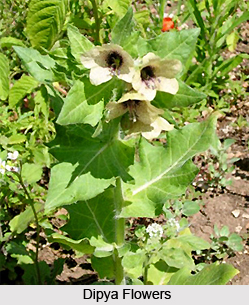 Dipya is an erect, annual or biennial herb which is found in India from Kashmir to Kumaon. The Botanical name of this plant is Hyoscyamus Niger L. There are various other names by which Dipya is known in different Indian languages which include Khorasaniajowan in Bengali, Khorasaniajmo and Khorasaniajvan in Gujarati, Khurasanivadakki and Khurasanivoma in Kannada, Bangidewana, Datura, Bazrbarlg and Sura in Punjabi, Kurasaniy-Omam in Tamil, Khoranasiyajwan in Urdu, Khurasaniajvayan, Khuro-Saniyamani and Khurasanijamani in Hindi language, Khorasanivova in Marathi, Khurasaniajvayan, Yavani and Parasikayavani in Sanskrit language and Kurinjiva-Mam and Khurashanivamam in Telugu. It occurs naturally in the western and northern Asia southwards to the temperate western Himalayas from Kashmir to Kumaon at altitudes between 2700 meters and 3700 meters. It is also cultivated in various other regions of India for its great medicinal value.
Dipya is an erect, annual or biennial herb which is found in India from Kashmir to Kumaon. The Botanical name of this plant is Hyoscyamus Niger L. There are various other names by which Dipya is known in different Indian languages which include Khorasaniajowan in Bengali, Khorasaniajmo and Khorasaniajvan in Gujarati, Khurasanivadakki and Khurasanivoma in Kannada, Bangidewana, Datura, Bazrbarlg and Sura in Punjabi, Kurasaniy-Omam in Tamil, Khoranasiyajwan in Urdu, Khurasaniajvayan, Khuro-Saniyamani and Khurasanijamani in Hindi language, Khorasanivova in Marathi, Khurasaniajvayan, Yavani and Parasikayavani in Sanskrit language and Kurinjiva-Mam and Khurashanivamam in Telugu. It occurs naturally in the western and northern Asia southwards to the temperate western Himalayas from Kashmir to Kumaon at altitudes between 2700 meters and 3700 meters. It is also cultivated in various other regions of India for its great medicinal value.
Dipya is an erect, more or less hairy and viscid annual or biennial herb with a disagreeable, fetid smell and robust stem. This plant grows to a height of 0.3 to 0.9 meters. This plant possess spreading radical leaves, stalked, oblong-ovate and are 15 to 20 centimetres long, margins coarsely sinuate-toothed and the stem (cauline) leaves are smaller, sessile, ovate and irregularly pinnatifid. The flowers of this medicinal plant of India are yellowish-brown or pale green in colour with purplish veins, funnel-shaped, sessile or sub-sessile and are borne in terminal cymes. Fruit (capsule) of Dipya are 1.3 centimeters in diameter, and are enclosed in the globose tube of the enlarged calyx. The seeds are numerous, minute, oval or kidney-shaped, and are about 1.5 millimetres long. The seeds are brown in colour and are marked with fine but conspicuous reticulations. The flowers and fruits of this plant are seen during the summer months.
The dried leaves and flowering tops of this medicinal plant constitute the drug henbane, valued mainly for its alkaloid content, mainly hyoscyamine and hyoscine. The leaves of Dipya possess sedative, anodyne, narcotic and mydriatic properties and are used as a sedative in nervous affections and irritable conditions like Whooping Cough or Dushta Kasa and asthma. It acts as a milder deliriant than belladonna (from deadly nightshade: Atropa belladonna: Solanaceae) but is more hypnotic and acts quickly. It is also used to counteract the griping action of purgatives and to give relief from spasms in the urinary tract. Poultices, plasters and medicated oils prepared from the seeds and leaves are used to relieve inflammatory swellings. The seeds of this plant also possess anodyne and narcotic properties although they are rarely used in medicine due to their toxicity in large doses. However, the smoke from burning seeds and powdered seeds are reportedly applied to provide relief from toothache, and a suppository prepared from seeds is used to give relief from painful affections of the uterus. All parts of this Indian medicinal plant possess alkaloids that are poisonous in large doses and therefore overdoses can result in delirium, coma and death.



















